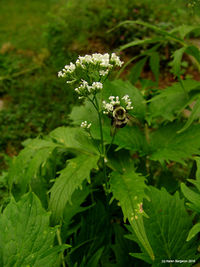Valeriana officinalis
| See Also | Botanical Monographs |
|---|
Valerian (Valeriana officinalis) is best known as a sedative herb used in the treatment of insomnia, especially when the insomnia is due to nervousness, grief or depression. To explore the characteristics, medicinal uses and prescribing considerations of this herb in more detail, check out the references indicated.[1], [2]
Contents
Characteristics
AKA V. jatamansii, V. edulis, V. sitchensis
- Common Names: Valerian, Belgian valerian, Common valerian, Fragrant valerian, Garden valerian
- Family: Valerianaceae
- Habitat: Valerian officinalis can be found in Europe and has been naturalized to North America.
- Parts Used: Root (60% alcohol)
- Constituents: Gamma-aminobutyric Acid (GABA), alkaloids, iridoids (valepotriates), volatile oils (valerenic acid)
- Medicinal Actions: sedative, anodyne, antispasmodic, anxiolytic, aromatic, carminative, nervine,
Uses
Medicinal Uses:
Internal
- anxiety, nervousness, and insomnia, despondent, mental depression with nervousness; insomnia from nervousness; insomnia from grief or loss, insomnia with depression
- irritable, pain, nervous excitement; nervous headache - hemicranium (pain on one side of the head); nervous palpitations
- decreased cerebral circulation, epilepsy, spasmodic movements, elevated blood pressure
External
- sleeplessness - used as a bath
- Insomnia is the indication with the most clinical studies.
Prescribing Considerations
- Need to give the herb for 1-2 weeks duration to see if an effect will occur.
- Dosing for insomnia - take 1 dose after dinner, another dose right before bed, keep a dose on the bedside table in case patient wakes up in the middle of the night.
- Most people do not like the odour of Valerian; this may decrease compliance.
The information provided is intended to augment the treatment from a naturopathic doctor or other trained medical professional. Although most herbs are generally safe, it is recommended that you avoid self-prescribing especially when there is an underlying ongoing medical condition, if you are on any prescription medications or if you are pregnant or breastfeeding.
Formulations and Preparation
- Tincture - 1-2 drachms three times daily, 1-3mL three times daily, usually 15-60 (1:2) drops three times daily, take every 30 minutes in acute cases
- Fluid extract - 5-30 drops (1:1) three times daily
- Powder - 10-30g daily
- Bath - 100g root in 2L of boiling water, the herb is added to bathwater to aid in relaxation
- Infusion (leaf) - 2 tsp/cup, let stand 12 hours (overnight), take cold, several times daily on an empty stomach
- Decoction - 2-3g/150mL of water
- Cold maceration - cold water on 2 tsp of root, let stand for 8-10 hours, take on empty stomach in the morning and evening
- Standardized extract - standardized to valerenic acid or valepotriate (1-1.5%), 160mg twice daily
1 drachm = 60 drops or 1 tsp or 1/8 ounce.
Dosing Trials
- 100mg daily up to 400-900mg daily (mostly trials for insomnia)
- Some trials used 1-3mL tincture daily to three times daily; most trials have been done with the standardized extract (using higher doses).
Safety
The safety and prescribing considerations for this herb include:[3], [4]
- Generally regarded as safe.
- Side-effect is sedation.
- Contraindicated in pregnancy and lactation.
- Caution: may impair driving and operation of hazardous machinery.
- Drug-Herb Interactions.[3]
- Benzodiazepines - Prevention or reduction of drug adverse effect, potential or theoretical beneficial or supportive interaction with professional management; Herb may reduce side effects of benzodiazepine withdrawal acting as a partial agonist at the same receptor, as well as an antidepressant, muscle relaxant, and other effects. Consider incorporating the herb into nutritional/botanical support protocols for drug tapers.
- Barbiturates and Other Central Nervous System Depressants - Potential or theoretical adverse interaction of uncertain severity; Herb will combine additively with centrally acting depressants at multiple receptors. Avoid herb-drug co-administration except in short-term/acute circumstances or specialized settings under professional management.
References
- ↑ Boon Heather, Smith Michael (2009) 55 Most Common Medicinal Herbs: The Complete Natural Medicine Guide Second Edition Institute of Naturopathic Education and Research, CCNM Toronto.
- ↑ Godfrey Anthony, Saunders Paul, Barlow Kerry, Gowan Matt (2011) Principles and Practices of Naturopathic Botanical Medicine, Advanced Botanical Medicine. V3 CCNM Press, Toronto.
- ↑ 3.0 3.1 Stargrove Mitchell Bebell, Treasure Jonathan, McKee Dwight L (2008) Herb, Nutrient and Drug Interactions: Clinical Implications and Therapeutic Strategies.
- ↑ Brinker Francis (1997) Herbal Contraindications and Drug Interactions: Plus Herbal Adjuncts With Medicines, 4th Edition Eclectic Medical Publications.
